Getting Started with Cross Media Intelligence in LiveRamp Clean Room
LiveRamp's Cross Media Intelligence (XMI) is an advanced measurement offering within LiveRamp Clean Room and its Build a Measurement Plan UI for marketers. XMI provides marketers with a single, deduplicated view of campaign performance across all measured media channels and partners—including linear TV, CTV, digital, social platforms, publishers, and demand-side platforms.
This topic is intended for users who are implementing XMI within the LiveRamp Clean Room UI.
Overall Implementation Steps
Getting started with XMI clean rooms typically involves the following overall steps:
Set Up Your Account
Once you've made the necessary implementation decisions and your LiveRamp Clean Room organization has been created, a user with the Account Admin role can start setting up your account. This involves setting up permission sets via roles and adding users. Roles are the different combinations of Clean Room access permissions you can create and assign to individual users. When you create users, you must assign them to a role.
Set Up SSO
To enable SAML-based SSO for LiveRamp Clean Room access to your account, follow the instructions in "Enable Single Sign-On for LiveRamp Applications".
Manage User Roles
As part of LiveRamp Clean Room organization configuration, account and organization administrators can manage and add new user roles. Roles are combinations of Clean Room permission sets that can be assigned to individual users within an organization.
Clean Room provides a set of optional default roles that can be used as a starting point when setting up your permission structure. To access default roles, from the Administration area of the navigation menu select Clean Room Configuration → Clean Room Roles to open the Organization Roles page. Default roles can be edited or deleted.
For more information, see "Managing Clean Room User Roles".
Add Users
Once your account administrator has access to the LiveRamp Clean Room UI, they can create additional users. There is a separate flow for adding users to the UI versus adding users to a clean room.
For more information on general file formatting guidelines, see "Data Connection Requirements and Best Practices".
Data Requirements for XMI
Your LiveRamp representative will work with you to prepare your data for upload to LiveRamp hosting based on your business needs.
Tip
Knowing where your datasets live, the credentials and tables required to access those datasets, and having the proper file and table formatting in place will make the remainder of your setup much more seamless.
Perform data validation in your environment before uploading your data to LiveRamp. This can significantly reduce processing time and avoid the need to troubleshoot problems later. For information, see "Data Validation".
First-Party Data
LiveRamp offers a recommended data schema for use with LiveRamp Clean Room implementations.
Audiences: A group of users or households based on attributes such as demographics, interests, behaviors, or purchase history. It likely includes all user identifiers (PII touchpoints or online identifiers) that will need to be used to resolve RampIDs.
Conversions: Provides a standard structure and definition of conversion data to support analysis and reporting across various data sources and platforms. The conversion schema allows you to measure a variety of conversions across different platforms, sources, and types of conversion goal events.
Audience Source
The Audience source lists the users and the segments they belong to. Each row represents a user and includes a CID or RampID, the segments they are part of, and the install date of the data.
Note
You can select a maximum of 5 first- or third-party segments per XMI report and measurement interval.
The lr_measurement_XMI_audience dataset has the following required fields:
Field Name | Data Type | Description | Example |
|---|---|---|---|
install_date | string | Date when the data was generated. This is used as the partitioning field. The system will choose the best date depending on the runtime context, so ensure it's accurate and consistent. | 2025-08-01 |
segment_ids | string | Comma-delimited list of segment IDs the user belongs to | mn.age_30-35,mn.male |
user_id | string | MD5-hashed CID or RampID of the user | XY1234Larry |
Example audience source table:
user_id,segment_ids,install_date "XY1234Larry","am.age_30-35,mn.male","2025-09-01" "AB5678Maria","am.age_25-29,mn.female","2025-09-01"
Audience Metadata Source
The Audience Metadata source provides human-readable labels for each segment ID. This is important for interpreting audience breakdowns in reports and UIs.
The lr_measurement_XMI_audience_metadata dataset has the following required fields:
Field Name | Data Type | Description | Example |
|---|---|---|---|
segment_id | string | The unique identifier for the audience | mn.male |
segment_name | string | A human-readable name for the audience | [Marketer Name] - 1p - Gender- Males |
Example audience metadata table:
segment_id,segment_name "mn.age_30-35", "[Marketer]- 1p - Age 30-35" "mn.male","[Marketer] - 1p - Gender - Males" "mn.age_25-29","[Marketer] - 1p - Age 25-29" "mn.female","[Marketer] - 1p - Gender - Females"
Conversion Data
To enable the use of conversion data across multiple Clean Room use cases, populate the following required fields and consider these guidelines:
Maintain schema consistency: If you lack data for a certain field, include its field name column and either null or default values.
Ensure measurement can be performed: Provide values for either the
gross_amtortrans_line_quantityfields (or both).Date partitioning: To optimize query performance via time-based filtering, use the
conversion_timestampfield.Unmatched records: Include records that do not match a RampID or are not associated with a CID (such as a loyalty member ID), because LiveRamp measurement uses unmatched data to scale results across a population, even when records are not tied to an ID.
Negative conversions: Remove rows for returned product, fraudulent charges, and other negative value conversions.
Field Contents | Recommended Field Name | Field Type | Values Required? | Description/Notes |
|---|---|---|---|---|
Brand name of the product | brand_name | string | No | Values required for Cross-Media Intelligence and Media Intelligence |
A unique user ID | cid | string | Yes |
|
Timestamp of the conversion event | conversion_timestamp | timestamp | Yes |
|
Unit price of a particular SKU/product ID in a transaction | gross_amt | double | Yes | Values are required for this field for Retail Intelligence Base Template, Cross-Media Intelligence, and Media Intelligence |
Unique identifier for SKU or product | product_id | string | Yes | (Foreign Key for Product Table) |
Units of a particular SKU/product ID in transaction | trans_line_quantity | int | No | Values are required for this field for Retail Intelligence Base Template, Cross-Media Intelligence, and Media Intelligence |
Unique identifier for the transaction | transaction_id | string | Yes |
Exposure Data
The following exposure data fields are required.
Field Contents | Recommended Field Name | Field Type | Values Required? | Description/Notes |
|---|---|---|---|---|
Unique ID for the brand | advertiser_id | string | No | Unique ID of the advertiser associated with the exposure event |
Name of the brand | advertiser_name | string | No | Values required for Quick-Start Insights, Cross-Media Intelligence, and Media Intelligence. |
A unique user ID | cid | string | Yes |
|
Unique identifier for the event | event_id | string | No |
|
UTC timestamp of the event | event_timestamp | timestamp | Yes | Example: 2025-09-18T02:33:03Z |
For more information on general file formatting guidelines, see "Data Connection Requirements and Best Practices".
Third-Party Data
Epsilon provides XMI with a catalog of third-party audience segments, which represent a group of users or households based on attributes such as demographics, interests, behaviors, or purchase history.
You can select up to 5 Epsilon segments per measurement period and report, and your LiveRamp representative will add them to your report.
To run effective measurement campaigns and generate actionable insights, consider the following when selecting audience segments from the Epsilon catalog:
Align to business objectives: Match the audience to your measurement goal, such as:
Brand awareness: Select broad demographic or lifestyle segments.
Sales impact: Focus on in-market or purchase-intent segments.
Customer retention: Use loyalty or behavioral segments.
Avoid overlap with your first-party data: Overlapping third-party audiences and first-party audiences can dilute your measurement results and make it harder to isolate performance differences.
The Epsilon catalog includes the following segment categories:
Segment Category = "Age"
Epsilon provides the following segment names for the corresponding age ranges:
A18-24
A21-24
A18-34
A21-34
A25-34
A25-49
A25-54
A25-64
A25-54 and A65+
A35-44
A35-54
A35-64
A35-64 and A18-24
A45-54
A55-64
A18-44
A18-49
A18-54
A18-64
A18+
A21+
A25+
A35+
A50+
A55+
A65+
Segment Category = "Gender/Age Bands – Male"
Epsilon provides the following segment names for the corresponding male age ranges:
A18-24
A21-24
A18-34
A21-34
A25-34
A25-49
A25-54
A25-64
A25-54 and A65+
A35-44
A35-54
A35-64
A35-64 and A18-24
A45-54
A55-64
A18-44
A18-49
A18-54
A18-64
A18+
A21+
A25+
A35+
A50+
A55+
A65+
Segment Category = "Gender/Age Bands – Female
Epsilon provides the following segment names for the corresponding female age ranges:
W18-24
W21-24
W18-34
W21-34
W25-34
W25-49
W25-54
W25-64
W35-44
W35-54
W35-64
W45-54
W55-64
W18-44
W18-49
W18-54
W18-64
W18+
W21+
W25+
W35+
W50+
W55+
W65+
Segment Category = "Income"
Epsilon provides the following segment names for the corresponding income ranges:
$0 - $19,999
$0 - $29,999
$20,000 - $29,999
$30,000 - $39,999
$30,000 - $49,999
$40,000 - $49,999
$0 - $49,999
$0 - $74,999
$50,000 - $74,999
$50,000+
$75,000 - $99,999
$75,000+
$100,000 - $124,999
$100,000+
$125,000 - $149,999
$125,000+
$150,000 - $174,999
$150,000+
$175,000 - $199,999
$200,000 - $249,999
$200,000+
$250,000+
Segment Category = "Household Composition"
Epsilon provides the following segment names for the corresponding types of households:
Male Present in HH
Female Present in HH
Children Present in HH
No Children Present in HH
One Child in HH
Two Children in HH
Three Children in HH
Four or More Children in HH
One Adult with Children in HH
Two Adults in HH
Two Adults in HH, Both Female
Two Adults in HH, Both Male
Three Adults in HH
Four or More Adults in HH
Single-Person HH, Male
Single-Person HH, Female
Single-Parent HH, Male
Single-Parent HH, Female
Segment Category = "Household Education"
Epsilon provides the following segment names for the corresponding levels of household education:
Some High School or Less
High School
Some College
College
Graduate School
Segment Category = "Housing Type / Living Situation"
Epsilon provides the following segment names for the corresponding housing types:
Owns Home
Rents
Set Up Media Tracking
Setting up media tracking for XMI involves specific steps for pixels, social media platforms like Meta, and integrating linear TV logs from partners. By connecting various data sources and leveraging LiveRamp's identity resolution and measurement tools, XMI provides a comprehensive and accurate view of campaign performance across the fragmented media landscape.
Pixel Setup for Display and Video Impressions
You can use the Cross Media Intelligence pixel to track display and video impressions across online, web, app, and connected TV devices.
Work with your LiveRamp representative to obtain your XMI tracking pixel, then deploy it on your assets, such as campaign landing pages, programmatic creatives, or publisher pages. Then verify that the pixel fires on all relevant user interactions.
The Cross Media Intelligence pixel uses the p.tvpixel.com domain and the following set of URL parameters and substitution macros. Only the aid and cb parameters are required, but the rest are recommended if applicable. Most of the parameters apply to both display and video.
URL Parameter | Macro Substitution | Description |
|---|---|---|
| N/A | Required: Your unique ID, which is provided by LiveRamp |
|
| Required: Makes the URL unique to avoid retrieving cached ad server responses |
|
| The ID of the ad or creative |
|
| Video only: The length of the ad or creative in seconds |
|
| The name of the ad or creative |
|
| The advertiser's ID |
|
| The name of the advertiser |
|
| The ID of the app bundle (if applicable) |
|
| The name of the app (if applicable) |
|
| The ID of the campaign |
|
| The name of the campaign |
|
| The unhashed advertising ID, such as the Google Advertising ID, IOS IDFA, Roku ID, or tvOS |
|
| Indicates whether ad tracking is limited (true) or not (false). |
|
| The type of device (if applicable) |
|
| Video only: Freewheel's customer ad ID (if applicable) |
|
| The height of the ad placement |
|
| The ID of the ad placement |
|
| The name of the ad placement |
|
| The publisher's ID |
|
| The ID of the user |
|
| The IP address of the user's device |
|
| Video only: The ID of the video or program |
|
| Video only: The title of the video or program |
|
| The width of the ad placement |
Configure the pixel so that it captures relevant user or event data. Consult your ad serving platform's documentation for guidance on third-party impression trackers and macros. Check logs and dashboards to verify that pixel events are recorded and transmitted as expected. Most parameters are flexible rather than strictly required. If a parameter is not used, it can be removed from the tag or passed with an empty value.
Example pixel:
https://p.tvpixel.com/com.snowplowanalytics.iglu/v1?schema=iglu%3Acom.dataplusmath%2Fvideo_impression%2Fjsonschema%2F1-0-0&aid=[LR_SPECIFIED_VALUE]&cb=[CACHEBUSTER]& pub_id=[PUBLISHER_ID]&width=[WIDTH]&height=[HEIGHT]&adv_id=[ADVERTISER_ID]&adv_n m=[ADVERTISER_NAME]&c_id=[CAMPAIGN_ID]&c_nm=[CAMPAIGN_NAME]&pl_id=[PLACEMEN T_ID]&pl_nm=[PLACEMENT_NAME]&ad_id=[AD_ID]&ad_nm=[AD_NAME]&ad_len=[AD_LENGTH ]&fw_caid=[FW_CAID]&u_id=[USER_ID]&u_ip=[USER_IPADDRESS]&v_id=[VIDEO_ID]&v_nm=[VI DEO_TITLE]&app_id=[APP_BUNDLE_ID]&app_nm=[APP_NAME]&dvc_typ=[DEVICE_TYPE]&dvc_ id=[DEVICE_ID_PLAIN]&dvc_lat=[LIMIT_AD_TRACKING]
Social Media Tracking
XMI has measurement integrations with walled garden social media platforms. For Meta, you need to enable their LiveRamp Clean Room partnership, create a dataset ID, and provide LiveRamp with access to your ad account in Meta Business Manager. LiveRamp can then extract certain metadata for reporting, such as the names of campaigns and creatives.
Go to your Meta Business Manager and then click on Business Settings from the left-hand menu.
From the left-hand menu, click Accounts and then select Ad Accounts.
Select the individual ad account to be shared with LiveRamp.
Select Assign Partners.
Select Business ID.
Enter LiveRamp's Business Manager ID: 705664196188477.
Enable View Performance and click .
For LiveRamp to receive exposure data from Meta, you need to create a Dataset ID within your Meta Business Manager account and attach the ad accounts you would like LiveRamp to measure.
Go to your Meta Business Manager and then click on Business Settings from the left-hand menu.
Select Data Sources → Datasets, and then click .
In the Create a Dataset ID form, enter "LiveRamp Measurement -
your_organization_name" in the Name field.In the Dataset ID section, select Assign partners to share the dataset ID with LiveRamp's Business Manager.
In the Share this Dataset with a Partner dialog, enter LiveRamp's Business Manager ID: 705664196188477.
Give LiveRamp full control by selecting Managed event dataset.
Click .
Contact your LiveRamp representative via email to share your dataset ID and dataset name so they can complete LiveRamp's steps to integrate your Meta dataset with XMI.
For more information, see "How to add a partner to a dataset in your business portfolio" in Meta's documentation.
Linear Creative Fingerprinting
To fingerprint your linear TV creatives for tracking, work with your LiveRamp representative to upload them. Your creatives must meet the following requirements:
File format: MP4 or MOV
File name: The creative's Industry Standard Commercial Identifier (ISCI) code and the file extension, such as "XEXA0415000H.mp4".
Resolution: 1080p
Frame rate: 24-30 frames per second
Bit rate: 4-40 megabits per second
Note
There is no maximum file size. However, if your creative exceeds 750 MB, you should manage its file size by reducing the bit rate or frames per second.
Connect Your Data
Create a data connection by performing the overall steps listed below. The type of connection to create will depend on your situation and business needs. Your LiveRamp representative will work with you to determine the types of connections to create.
You can send data to LiveRamp through SFTP or by setting up a connection to your S3 or GCS buckets. For more information about sending data to LiveRamp, see "Getting Your Data Into LiveRamp" and "Uploading Data".
For more information on the individual steps to perform for your cloud provider and clean room type, see the following articles:
Tip
If you are a LiveRamp Analytics Environment customer, work with your LiveRamp representative to connect your existing data.
You need to create a data connection for each dataset you want to use in an XMI clean room. After you create data connections, these connections appear on the Data Connections page, and you can then create and configure clean rooms.

Perform Actions in the Cloud Provider UI
For certain data connections, you’ll have to perform tasks in the cloud provider’s UI. This often involves things like downloading credentials, creating service keys, granting permissions, generating a token, or other similar actions.
Add Credentials
For LiveRamp to be able to access your data at your cloud provider, you’ll need to create a credential within LiveRamp Clean Room for that cloud account. This often involves entering a credential or token you generate from your cloud provider.
Create a Data Connection
Once you've created the appropriate credentials, you can create the data connection itself. During this process, you’ll also specify things like the file path LiveRamp should use to access your data, the file format, the field delimiter, and the data location.
Map the Fields
Once you’ve created the appropriate data connection and LiveRamp has successfully connected to your data, you then map and configure the fields. This includes specifying which fields you want to be queryable, any updates to column labels, which fields contain PII, and which fields should be used as identifiers.
Configure Clean Rooms
Your LiveRamp representative will create clean rooms for your organization. You can then configure clean rooms by performing the following steps:
Access XMI Dashboards in Clean Room Intelligence
Once you've connected your data, configured your clean room, and your question runs complete, you can view your XMI dashboards in Clean Room Intelligence.
For more information on accessing Clean Room Intelligence, see "Intelligence Access and Structure.
For more information on accessing Clean Room reports, see "Create a Question Run".
XMI Reports
Clean Room Intelligence provides a dashboard with the following XMI reports so that marketers can measure reach, frequency, lift, attribution, and incrementality across all channels, gaining clear insights into overall media performance:
All cut types used for these reports are assigned during the mapping process.
Reach and Frequency:
Projected Scaled Reach Frequency (PSRF): Provides impressions delivered and households reached, and the frequency of those impressions for the following standard cut types.
Brand: Provides the overall, cross-channel view of the data
Creative: The visual elements of the advertisement, such as "Super Bowl :30" or "Promo Weekend :15")
Channel: The type of media platform where a campaign was executed, such as "Linear", "OTT", or "Display"
Property: For TV, property is the TV network where an ad was served within a campaign (such as "ABC" or "ESPN"). For digital, property can be the publisher or a more granular classification of the data, such as "DV360" or "DV360 - 3P Targeting".
Publisher: The owner of the ad space in which the ad was served, such as "DV360" or "Peacock". For TV, "Linear" indicates that exposures are all sourced from the same place.
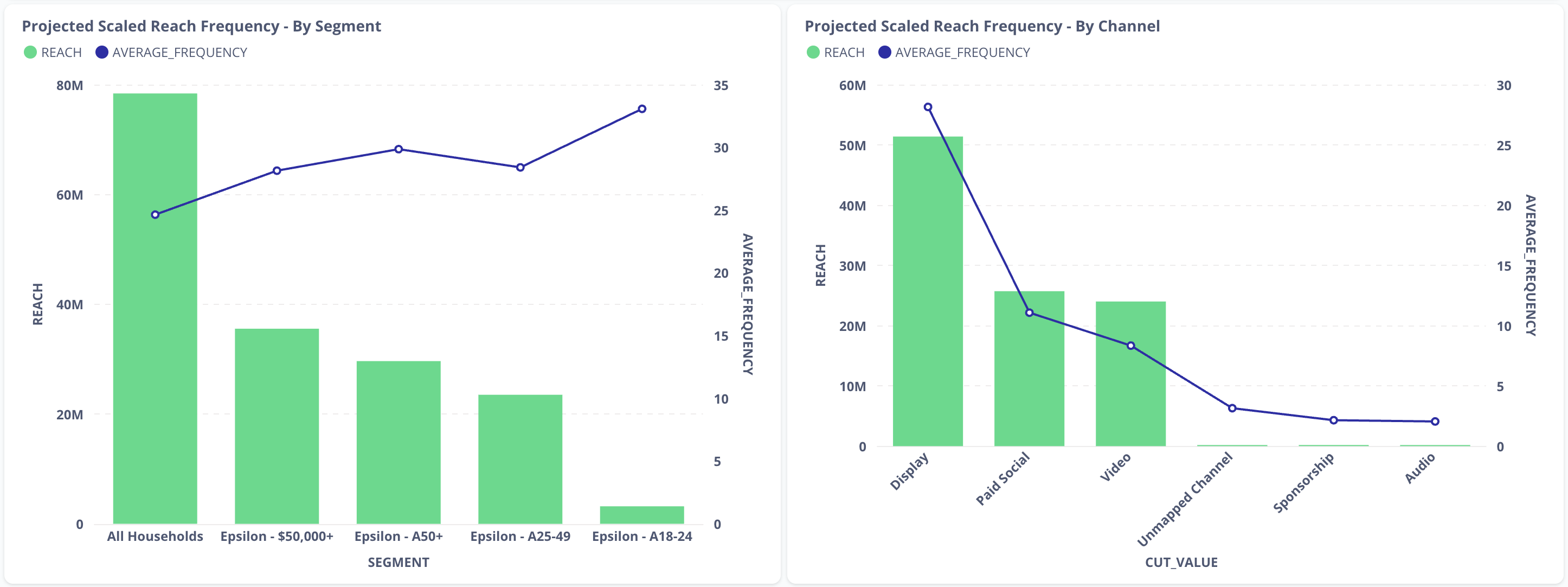
Cumulative Reach: Provides the total number of unique households that have been exposed to a media campaign over time. XMI reports cumulative reach on a weekly basis throughout the campaign, showing how the audience grows with each subsequent week.
Cumulative Reach reports can be segmented by the following standard cut types to help you see both overall and detailed household-level reach across all platforms:
Brand: Provides the overall, cross-channel view of the data
Channel: The type of media platform where a campaign was executed, such as "Linear", "OTT", or "Display"
Property: For TV, property is the TV network where an ad was served within a campaign (such as "ABC" or "ESPN"). For digital, property can be the publisher or a more granular classification of the data, such as "DV360" or "DV360 - 3P Targeting".
Publisher: The owner of the ad space in which the ad was served, such as "DV360" or "Peacock". For TV, "Linear" indicates that exposures are all sourced from the same place.
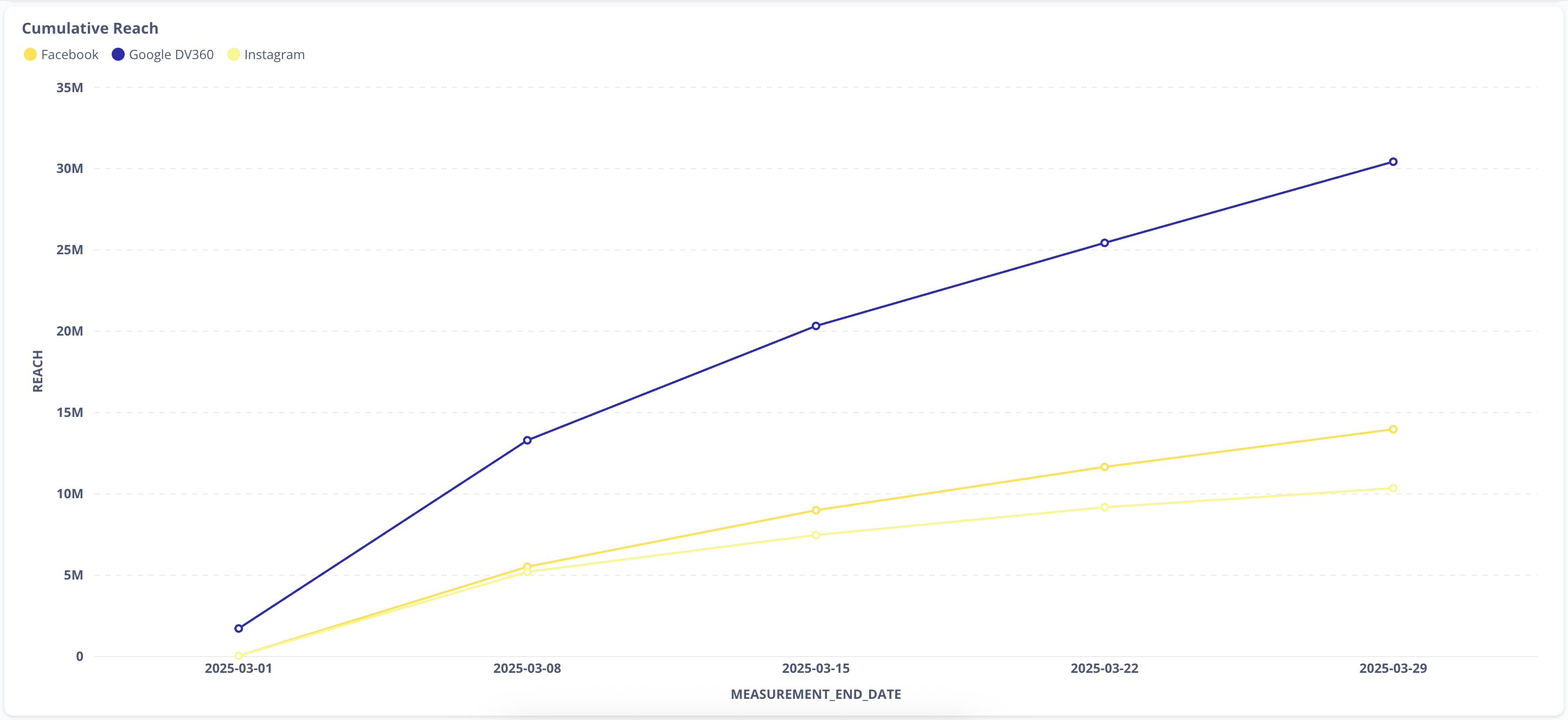
Unique/Overlapping Reach ("Only-Only-Both"): Shows both unique (incremental) and shared (overlapping) reach and impressions across different platforms or properties, enabling you to identify which media sources contribute new audience exposure and where households are seeing your campaign on multiple channels. It offers the following standard cut types.
Channel: The type of media platform where a campaign was executed, such as "Linear", "OTT", or "Display"
Property: For TV, property is the TV network where an ad was served within a campaign (such as "ABC" or "ESPN"). For digital, property can be the publisher or a more granular classification of the data, such as "DV360" or "DV360 - 3P Targeting".
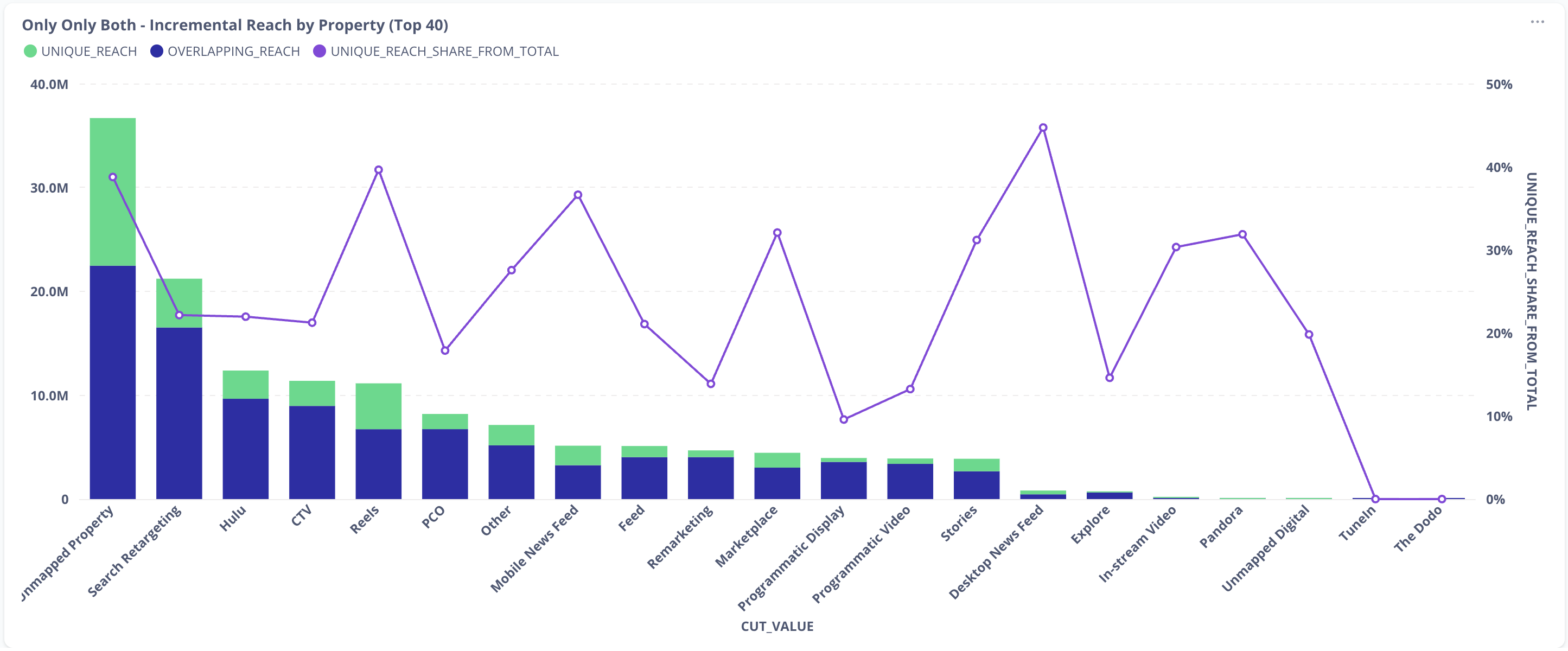
Lift and Attribution:
Attribution: Links media exposures to outcomes (such as purchases or site visits), so advertisers can see which channels, publishers, creatives, or touchpoints actually drove results. Conversion credit is evenly distributed across all touchpoints within the attribution window leading up to the conversion. It offers the following standard cut types.
Brand: Provides the overall, cross-channel view of the data
Creative: The visual elements of the advertisement, such as "Super Bowl :30" or "Promo Weekend :15")
Channel: The type of media platform where a campaign was executed, such as "Linear", "OTT", or "Display"
Property: For TV, property is the TV network where an ad was served within a campaign (such as "ABC" or "ESPN"). For digital, property can be the publisher or a more granular classification of the data, such as "DV360" or "DV360 - 3P Targeting".
Publisher: The owner of the ad space in which the ad was served, such as "DV360" or "Peacock". For TV, "Linear" indicates that exposures are all sourced from the same place.

Incrementality: Measures the true impact of your campaign at the household level by separating outcomes driven by media (attributed conversion) from those that would have occurred naturally (baseline conversion). It uses the Brand cut type (the overall, cross-channel view of the data).
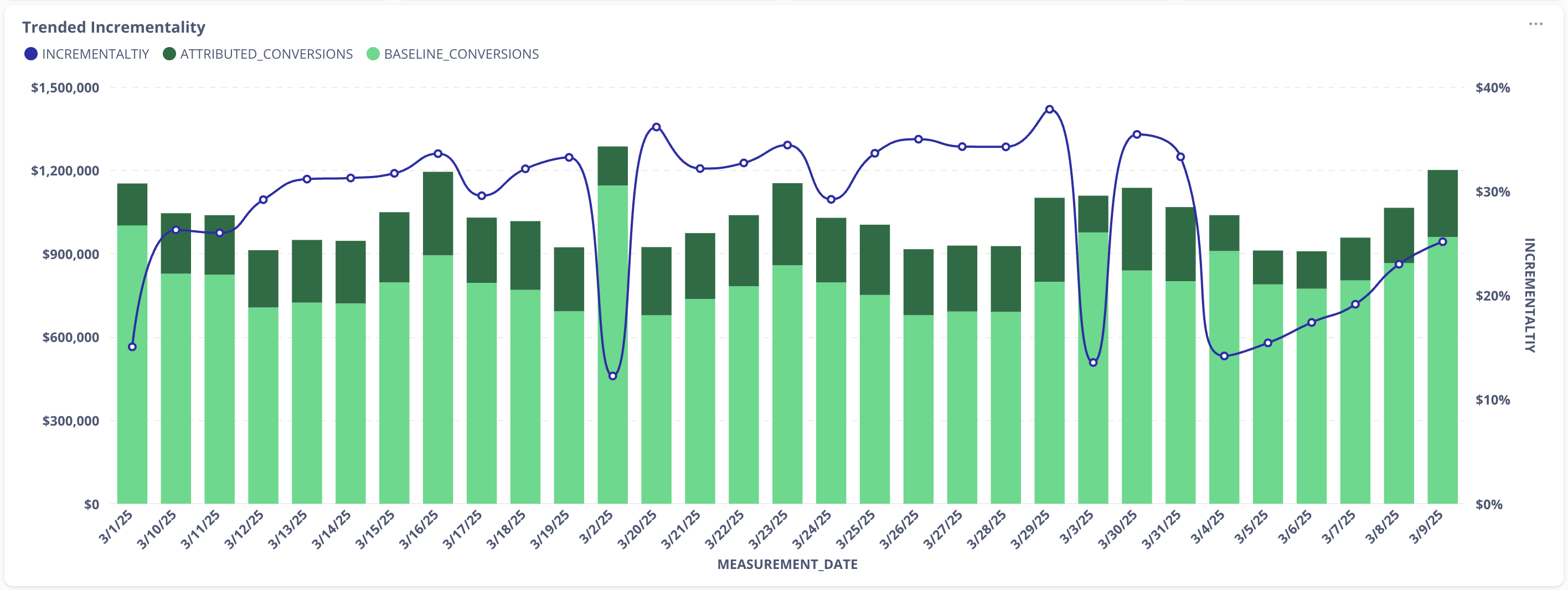
Lift: Compares the conversion behavior of households exposed to a campaign with a similar control group (using a propensity score model). This shows which conversions can be attributed to media and helps identify the optimal frequency and the point where additional exposure no longer drives results. It uses the Brand cut type (the overall, cross-channel view of the data).
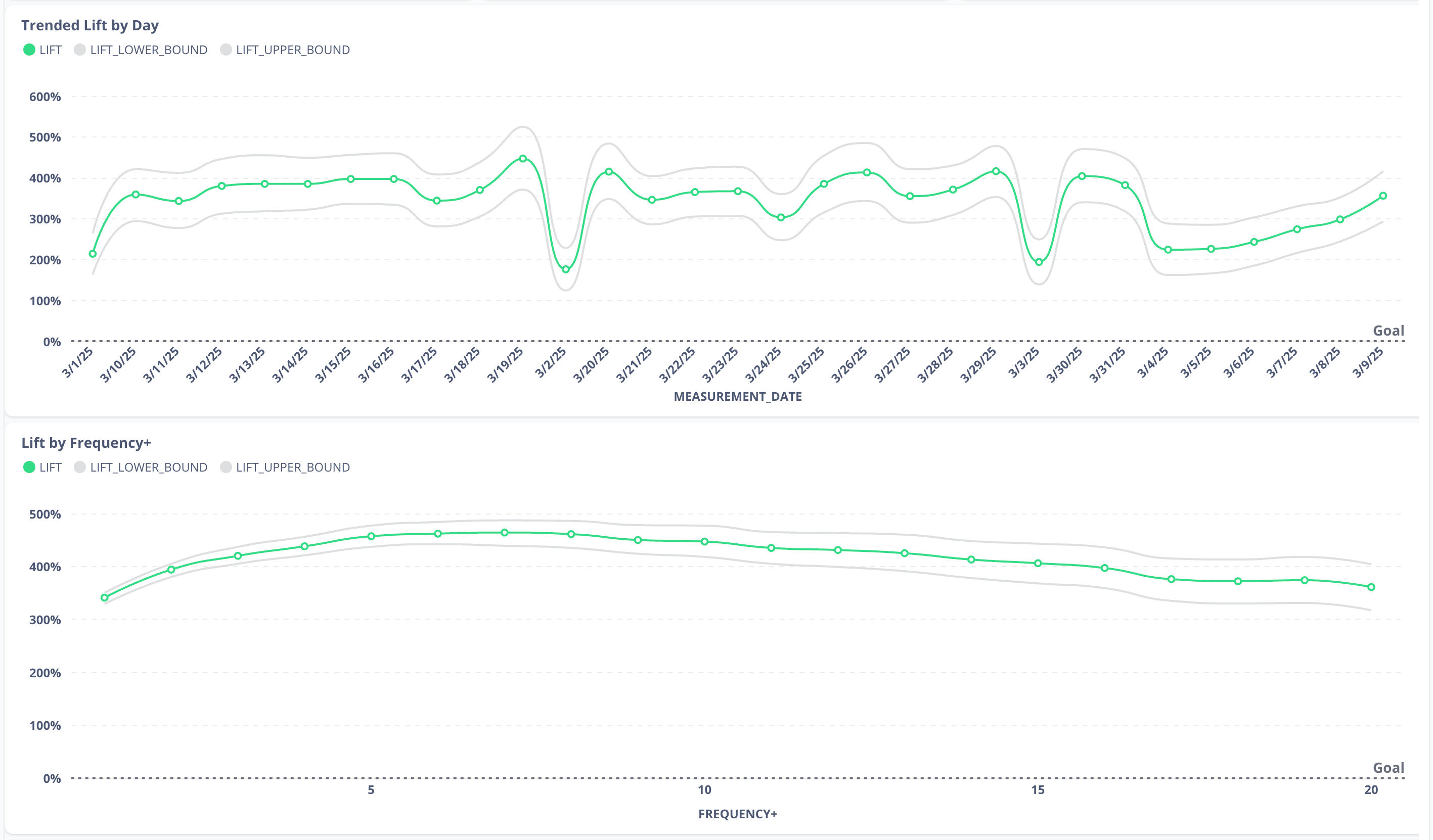
XMI FAQs
Does XMI support individual- or household-level reporting?
XMI is designed for deduplicated, household, or aggregate audience measurement. Individual-level reporting is not supported due to privacy and modeling constraints.
What are the standard reporting cuts supported in XMI?
Reporting cuts typically include brand, sub-brand, campaign, channel, publisher, property, and creative. Currently, standard reporting outputs only include standard cuts. Custom cuts would require separate question runs, setup, and testing, so they are not currently supported. For information on standard reporting cuts, see "XMI Reports".
What are the standard data sources in XMI?
XMI integrates data from various sources, including linear TV, CTV, programmatic, and social (Meta). Standard data sources typically include:
Epsilon audiences: Demographic and behavioral segments of households and individuals that enable detailed audience analysis
Pixel exposure feed: Digital media exposures captured by a LiveRamp pixel placed on a brand advertiser's media tags and associated conversions
Vizio Inscape universe: A comprehensive, nationally representative linear TV dataset from Vizio Smart TV viewers
Direct publisher logs: Ad exposure data sourced directly from individual publishers to provide a comprehensive and high-fidelity view of cross-media campaign performance
Brand data assets: Your connected data assets
The inclusion of each publisher or partner is subject to specific eligibility and approval based on the brand, campaign, and media plan. Partner combinations are not guaranteed.
If I already have a data connection in LiveRamp Clean Room, can I also use it for XMI?
An existing data connection in LiveRamp Clean Room can generally be reused for XMI if it is hosted by LiveRamp, such as in Analytics Environment. Additional mapping files may be needed, such as CID-to-RampID mapping.
How can I avoid data quality issues?
Missing or malformed data in exposures, conversions, or audience feeds can cause failures or empty reports. You should validate data in your own environments using LiveRamp's sample schemas. For more information, see "Data Validation".
Can I include only Meta in XMI reporting?
No, XMI is not offered as a Meta- or social-only measurement solution. The standard scope requires both Meta and at least one additional partner.
How are audience and conversion data handled for use with Meta?
To include Meta in XMI, you must provide suitable first-party or licensed third-party conversion data. Meta integration cannot be approved without conversion data, and there is a minimum volume threshold that varies by campaign size.
Can I specify reporting cuts by DMA or regional breakdowns?
No, geographic/DMA-level measurement is not supported. XMI is a national-level, synthetic control model and is best suited for national campaign reporting.
Can I access the underlying row-level data for my own BI analytics?
XMI provides summaries and dashboards and supports exports for further BI analysis at an aggregated level. Raw match rates and underlying event-level datasets are not available in XMI, and export of row-level data is restricted. However, custom analytics is a feature of other LiveRamp Clean Room offerings.
How many segments can I use in XMI reports?
You can select a maximum of 5 first- or third-party segments per XMI report and measurement interval.
How many conversion goals can I select?
You can analyze up to 5 distinct conversion goals, such as site visits or in-store purchases, within a single XMI lift or attribution report. Each goal has its own data connection or table.
What is the difference between projection and scaling?
Within XMI's Projected Scaled Reach Frequency (PSRF) report, projection refers to extrapolating measurements from a curated sample to represent the entire national population and derive household-level weights for a sample of observed households. Scaling refers to adjusting in-panel digital measurements back to the recorded total impressions to correct for any match rate loss between digital native IDs and LiveRamp households.
What is the refresh cadence for third-party audiences?
The refresh cadence for third-party audiences is monthly.
What is the minimum query threshold for results?
XMI enforces a minimum query threshold (k-min) of 100 households, meaning queries will only produce results if they include more than 100 households.
Why doesn't XMI offer activation?
XMI is optimized for deduplicated campaign reporting (such as reach, frequency, audience overlap, attribution, and lift) across multiple publishers and media channels. Data is summarized at aggregate (not individual) levels for use in dashboards and visualizations to inform marketing strategy and optimize media spend.
XMI is expressly built on privacy-first modeling and publisher aggregation and does not produce exportable audiences as part of standard output. However, other LiveRamp Clean Room offerings include activation.